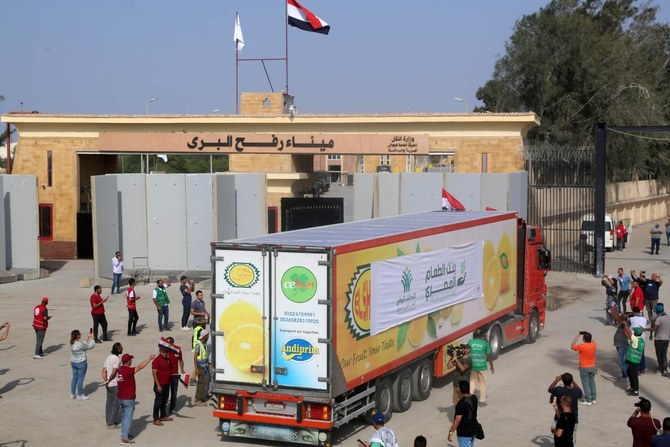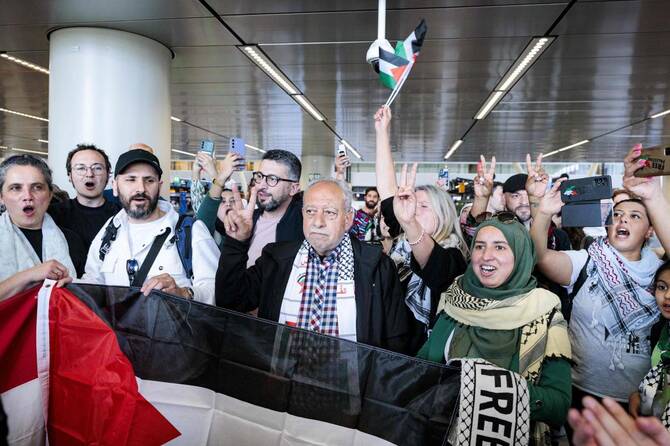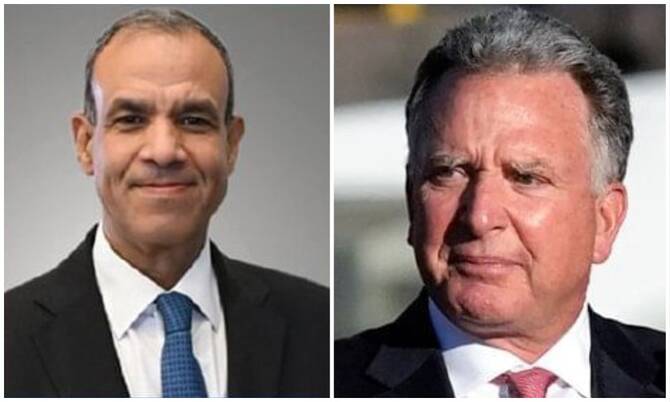RAFAH, Gaza Strip: The second aid convoy destined for desperate Palestinian civilians reached Gaza on Sunday, as Israel widened its attacks to include targets in Syria and the occupied West Bank and the Israeli prime minister warned Lebanon’s Hezbollah militant group that if it launches its own war, “we will cripple it with a force it cannot even imagine.”
On Saturday, 20 trucks entered Gaza in the first aid shipment into the territory since Israel imposed a complete siege two weeks ago.
Israeli authorities said late Sunday they had allowed a second batch of aid into Gaza at the request of the United States. COGAT, the Israeli defense body responsible for Palestinian civilian affairs, said the aid included water, food and medical supplies and that everything was inspected by Israel before it was brought into Gaza.
The UN agency for Palestinian refugees confirmed the arrival of 14 trucks.
Israel has not allowed any fuel to enter Gaza.

In a sign of how precarious any movement of aid remains, the Egyptian military said Israeli shelling hit a watchtower on Egypt’s side of the border, causing light injuries. The Israeli military apologized, saying a tank had accidentally fired and hit an Egyptian post, and the incident was being investigated.
Relief workers said far more aid was needed to address the spiraling humanitarian crisis in Gaza, where half the territory’s 2.3 million people have fled their homes. The UN humanitarian agency said Saturday’s convoy carried about 4 percent of an average day’s imports before the war and “a fraction of what is needed after 13 days of complete siege.”
The Israeli military said the humanitarian situation was “under control,” even as the UN called for 100 trucks a day to enter.
Israel repeated its calls for people to leave northern Gaza, including by dropping leaflets from the air. It estimated 700,000 have already fled. But hundreds of thousands remain. That would raise the risk of mass civilian casualties in any ground offensive.
Israeli military officials say Hamas’ infrastructure and underground tunnels are concentrated in Gaza City, in the north, and that the next stage of the offensive will include unprecedented force there. Israel says it wants to crush Hamas. Officials have also spoken of carving out a buffer zone to keep Palestinians from approaching the border, though they have given no details.
Hospitals packed with patients and displaced people are running low on medical supplies and fuel for generators, forcing doctors to perform surgeries using sewing needles, resorting to vinegar as disinfectant and operating without anesthesia.
The World Health Organization says at least 130 premature babies are at “grave risk” because of a shortage of generator fuel. It said seven hospitals in northern Gaza have been forced to shut down due to damage from strikes, lack of power and supplies, or Israeli evacuation orders.
Shortages of critical supplies, including ventilators, are forcing doctors to ration treatment, said Dr. Mohammed Qandeel, who works in Khan Younis’ Nasser Hospital. Dozens of patients continue to arrive and are treated in crowded, darkened corridors, as hospitals preserve electricity for intensive care units.
“It’s heartbreaking,” Qandeel said.
Palestinians sheltering in UN-run schools and tent camps are running low on food and are drinking dirty water.
The lack of fuel has crippled water and sanitation systems.
Heavy airstrikes were reported across Gaza, including in the southern part of the coastal strip, where Israel has told civilians to seek refuge. At the Al-Aqsa hospital in Deir Al-Balah, south of the evacuation line, several bodies wrapped in white shrouds were lined up outside.
Khalil Al-Degran, a hospital official, said more than 90 bodies had been brought in since early Sunday, as the sound of nearby bombing echoed behind him. He said 180 wounded people had arrived, mostly children, women and the elderly displaced from other areas.
Airstrikes also smashed through the marketplace in the Nuseirat refugee camp. Witnesses said at least a dozen people were killed.
The Israeli military has said it is striking Hamas fighters and installations and insists it does not target civilians.
Palestinian militants have fired over 7,000 rockets at Israel, according to the military, and Hamas says it targeted Tel Aviv early Sunday.
More than 1,400 people in Israel have been killed — mostly civilians slain during the initial Hamas attack. At least 212 people were captured and dragged back to Gaza.
Two Americans were released Friday, hours before the first shipment of humanitarian aid.
More than 4,600 people have been killed in Gaza, according to the Hamas-run Health Ministry. That includes the disputed toll from a hospital explosion.






















